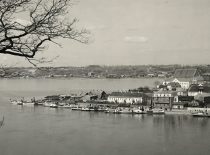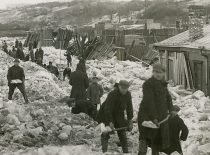If you wish to use the photographs published in the exhibitions, please write a free-form request to the Director of the KTU Library and obtain her permission.
Kaunas in Old Photographs (3–4th Decades of the 20th Century)
From the History of Photography
In 1839 Paris, the possibility of capturing an image on a silver plate called a daguerreotype1 was announced. A month later, photography was introduced in Lithuania, and the photos of Verkiai Palace were taken in the summer.
In 1918, after Lithuania’s declaration of independence, Kaunas became a centre of photography. After the First World War there were only three photographers left in Kaunas, but every year the number of photographers grew, and photography studios began to appear not only in the city centre, but also in Šančiai, Vilijampolė and Žaliakalnis districts. In 1922 there were 16 photography studios in Kaunas, and by the end of the 1930s there were about 50 workshops that were competing against amateur photographers2.
Probably the most creative studio photographer at that time was Karlas Baulas. Around 1926 he moved to Kaunas and set up a workshop in Šančiai, and later on Laisvės Avenue he worked at the “Economic Soldiers’ Company Photo Studio”, and at his own photography studio. According to photography historian Virgilijus Juodakis, Baulas had thoroughly studied the portraits painted by the old masters of art, their composition, lighting, hand position, which led to his understanding that similarity in a portrait is only half of the work, and that it still requires ingenuity, imagination, and the ability to see objects and phenomena in a unique way. The photographer used to say that “the client is clay and has to be kneaded”3.
In 1922, contacts between the press and photography intensified. The number of photographs in the press increased when zincographies from “Ostra” and “Grafika” printing houses began to appear in Kaunas, “and in particular, from 1929 to 1930, when the “Spindulys” printing house got its own zincography print.”4 In terms of information, photography has been attempted to be made equivalent to the text, as several photographs have been used to create photo-narratives.5 Organisation of photography exhibitions was an important step. In 1932, photographer, writer, journalist and educator Petras Babickas organised the first personal exhibition of artistic photography in Lithuania. He exhibited over 300 photographs at the Showroom of the Society of Independent Artists. Around 2,000 photography enthusiasts visited the exhibition6.





